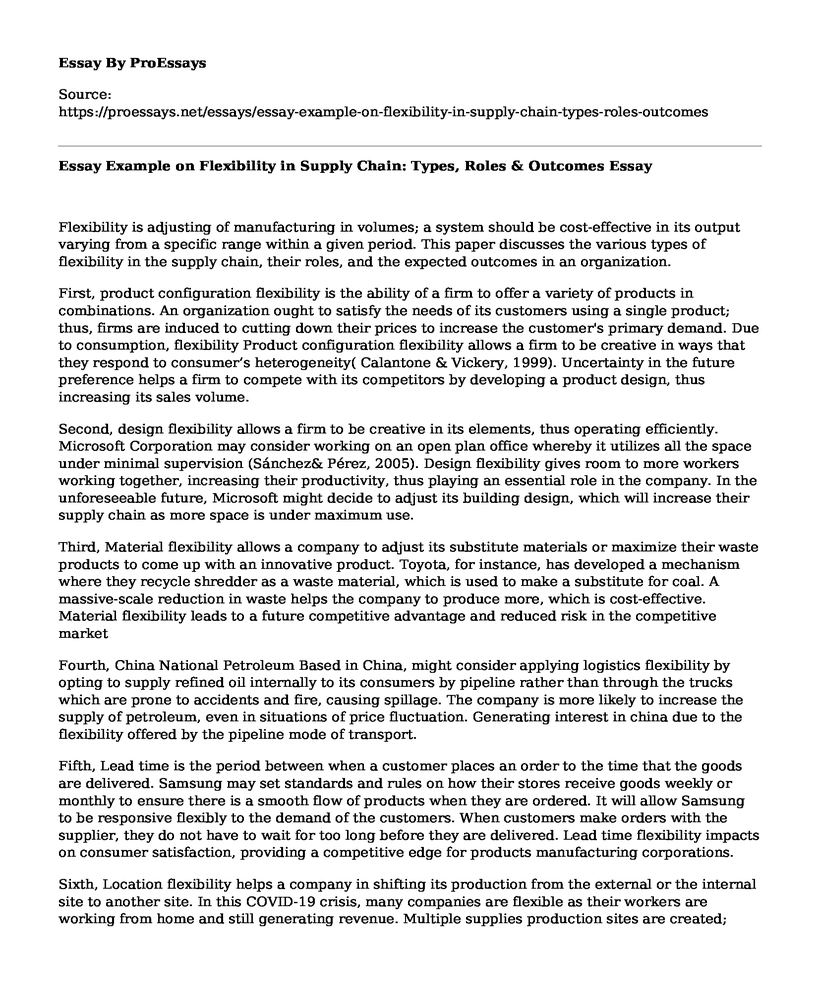Flexibility is adjusting of manufacturing in volumes; a system should be cost-effective in its output varying from a specific range within a given period. This paper discusses the various types of flexibility in the supply chain, their roles, and the expected outcomes in an organization.
First, product configuration flexibility is the ability of a firm to offer a variety of products in combinations. An organization ought to satisfy the needs of its customers using a single product; thus, firms are induced to cutting down their prices to increase the customer's primary demand. Due to consumption, flexibility Product configuration flexibility allows a firm to be creative in ways that they respond to consumer’s heterogeneity( Calantone & Vickery, 1999). Uncertainty in the future preference helps a firm to compete with its competitors by developing a product design, thus increasing its sales volume.
Second, design flexibility allows a firm to be creative in its elements, thus operating efficiently. Microsoft Corporation may consider working on an open plan office whereby it utilizes all the space under minimal supervision (Sánchez& Pérez, 2005). Design flexibility gives room to more workers working together, increasing their productivity, thus playing an essential role in the company. In the unforeseeable future, Microsoft might decide to adjust its building design, which will increase their supply chain as more space is under maximum use.
Third, Material flexibility allows a company to adjust its substitute materials or maximize their waste products to come up with an innovative product. Toyota, for instance, has developed a mechanism where they recycle shredder as a waste material, which is used to make a substitute for coal. A massive-scale reduction in waste helps the company to produce more, which is cost-effective. Material flexibility leads to a future competitive advantage and reduced risk in the competitive market
Fourth, China National Petroleum Based in China, might consider applying logistics flexibility by opting to supply refined oil internally to its consumers by pipeline rather than through the trucks which are prone to accidents and fire, causing spillage. The company is more likely to increase the supply of petroleum, even in situations of price fluctuation. Generating interest in china due to the flexibility offered by the pipeline mode of transport.
Fifth, Lead time is the period between when a customer places an order to the time that the goods are delivered. Samsung may set standards and rules on how their stores receive goods weekly or monthly to ensure there is a smooth flow of products when they are ordered. It will allow Samsung to be responsive flexibly to the demand of the customers. When customers make orders with the supplier, they do not have to wait for too long before they are delivered. Lead time flexibility impacts on consumer satisfaction, providing a competitive edge for products manufacturing corporations.
Sixth, Location flexibility helps a company in shifting its production from the external or the internal site to another site. In this COVID-19 crisis, many companies are flexible as their workers are working from home and still generating revenue. Multiple supplies production sites are created; thus, there is a sufficient flow of goods. Ensure that companies do not come at a halt in the future, they should maintain supply; therefore, though at a minimal revenue, their customers do not have to find alternatives (Tomlin& Tang, 2008).
References
Sánchez, A. M., & Pérez, M. P. (2005). Supply chain flexibility and firm performance. International Journal of Operations & Production Management.
Tang, C., & Tomlin, B. (2008). The power of flexibility for mitigating supply chain risks. International journal of production economics, 116(1), 12-27.
Vickery, S. N., Calantone, R., & Dröge, C. (1999). Supply chain flexibility: an empirical study. Journal of supply chain management, 35(2), 16-24
Cite this page
Essay Example on Flexibility in Supply Chain: Types, Roles & Outcomes. (2023, Sep 02). Retrieved from https://proessays.net/essays/essay-example-on-flexibility-in-supply-chain-types-roles-outcomes
If you are the original author of this essay and no longer wish to have it published on the ProEssays website, please click below to request its removal:
- Customers in Co-Creation of Products and Services
- Importance, Relevance and Purpose of Business Law Paper Example
- Market Analysis and Competitor Analysis of Three-Seasons Hotel
- E-Marketing Plan for Grid Analytics Ltd
- Essay Example on Leadership: Indra Nooyi's Role in PepsiCo's Success
- Essay on Loyalty Rewarded: Assessing the Impact of Consumer Effort on Random Marketing Outcomes
- Paper Sample on Global Leadership: Essential for International Business







